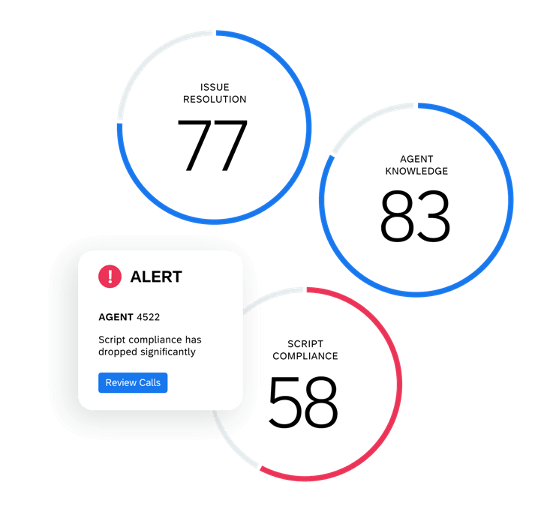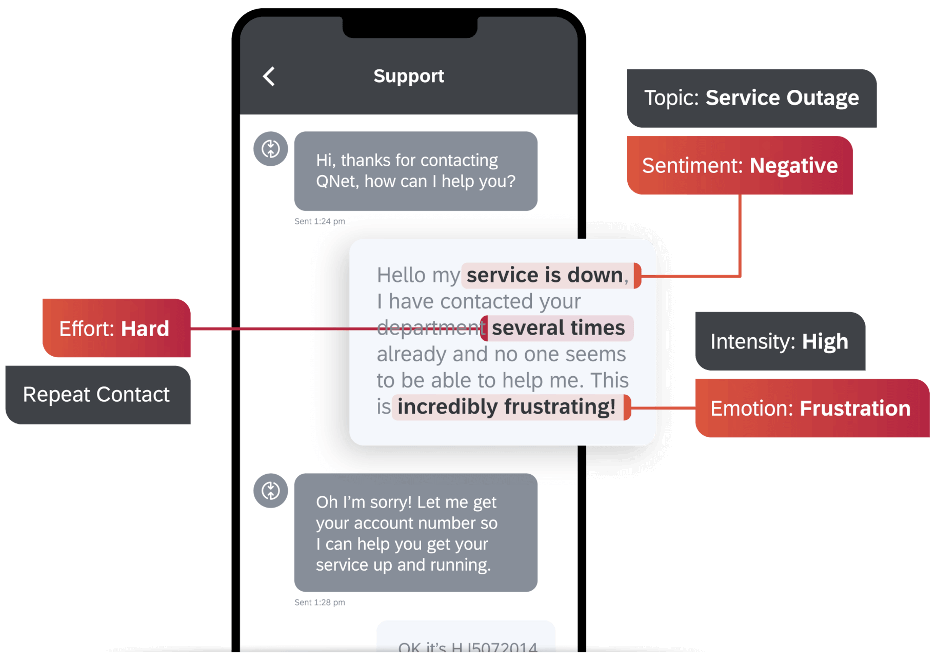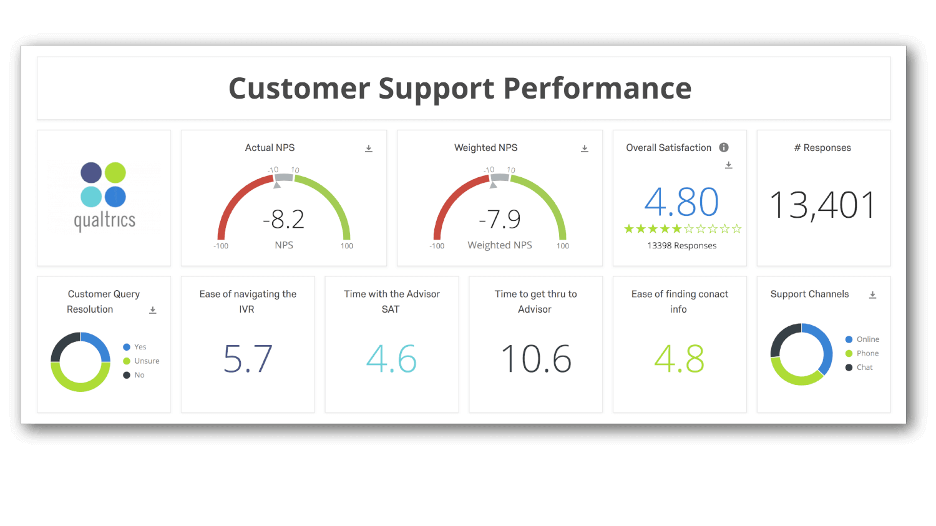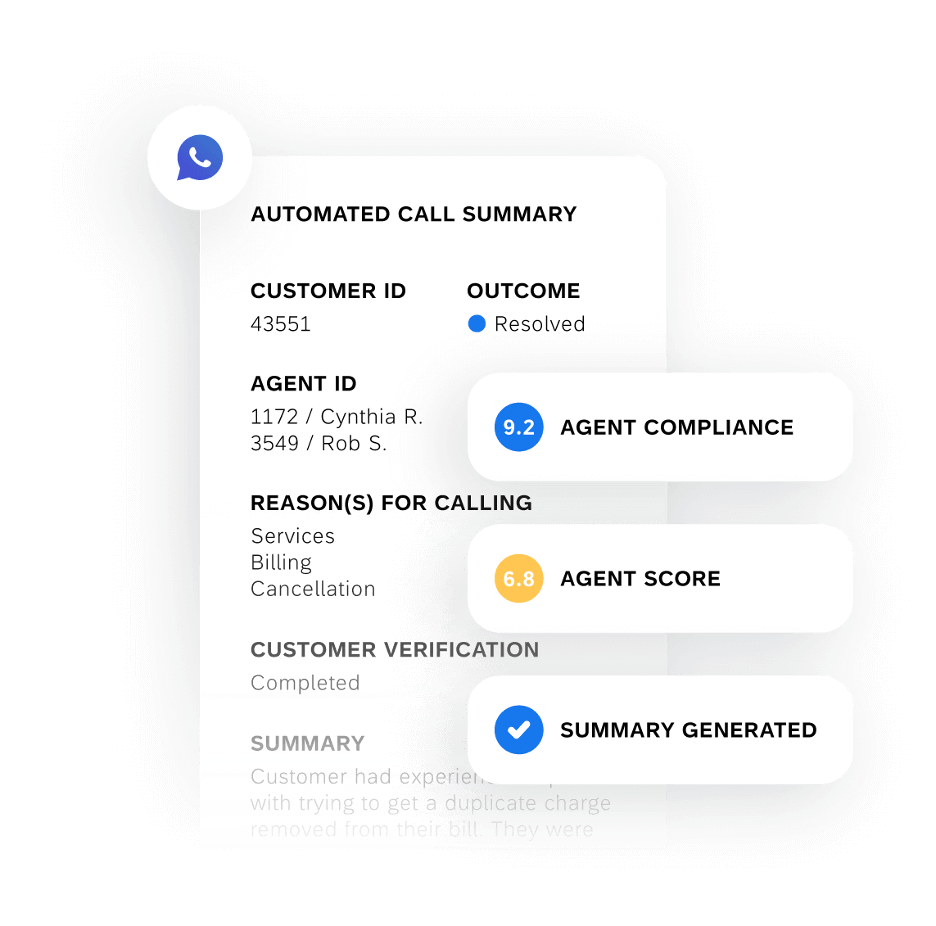What is agent productivity?
At its most basic, agent productivity can be defined as the time it takes an agent to resolve a customer interaction, such as phone calls. The more “productive” an agent, the more customer calls or other interactions they can complete during their working day.
However, agent productivity ideally is more nuanced and customer centric in nature. If an agent takes longer to reach contact resolution, but the customer is so impressed that they give the brand a higher score in customer satisfaction (CSAT) and Net Promoter Score (NPS) surveys, this could also be considered productive.
After all, an agent might be very productive in terms of calls answered in a day – but if they’re leaving customers feeling unhappy and dissatisfied, the overall impact on the business might be more negative than positive.
Balancing these two goals – quickly resolving customer interactions and exceeding customer expectations – can be difficult, but with the right measurement tools in place and an adaptive approach, it is possible to improve agent productivity over time.
Read on to understand how to optimise your contact and call centres and cultivate agent productivity.
Start improving your productivity with Qualtrics CustomerXM.
Why is agent performance so critical for contact centre productivity and business success?
Call centre productivity leads to financial rewards
When a call centre is productive and leaves customers satisfied, there’s significant financial rewards. Customers who rate an experience 5/5 stars are more than twice as likely to buy again, and 80% of satisfied consumers will spend more.
Investing in call centre productivity and reducing customer effort has a positive effect on a brand’s finances as customers return to purchase more.
Call centre agents make or break customer experiences
Call centre agent productivity and performance is a large part of the customer experience puzzle. When we surveyed consumers, 6.2% said helpful agents made them happy in their contact centre experience and 5.2% said agent empathy made a difference. When considering how “productive” agents are, it is clear their approach to customer service is a key factor. Note that only 2.7% of customers we surveyed valued low wait times, which is usually a significant metric when measuring contact centre performance.
Highly productive agents save you money
When agents are highly productive, they reduce your cost to serve and increase your customer lifetime value. When they’re able to quickly resolve customer issues on the first contact and inspire customers to recommend your brand to others, they lower the cost of maintaining customer relationships and help you to build new ones.
Another key point is that productive, high-performing agents also protect your revenue – there’s an 8% revenue loss risk when customers have bad experiences. Investing in your agents’ productivity actively helps to reduce this risk by improving customer experiences.
How do you calculate centre agent productivity?
When calculating call centre agent productivity, there are several measures you can use to understand how your support team is performing. These can be used as the baseline for key performance indicators (KPIs) for future evaluations.
Centre agent productivity metrics
For individual evaluation, the most valuable contact centre productivity metrics are:
First Call Resolution / First Contact Resolution (FCR) rate
How often do your agents properly handle a customer query or issue on the first contact or call? Understanding if your agents are transferring or escalating a call – or if your customer is having to contact your company again about the same issue – can help you understand agent productivity. A high FCR rate is a good indicator of great agent performance.
Average Speed of Answer (ASA)
This metric demonstrates the average response time it takes for your agents to answer a customer call. It is calculated by taking the total time waited for a call to be answered and dividing it by the total number of answered calls. A sign of great agent productivity is a low ASA rate.
Percentage of call transfers
The percentage of calls transferred describes the number of calls that agents have had to send on to another team member, superior or department to handle. Calculating this percentage is simple: take the total number of calls transferred, and divide by the total number of calls answered and multiply by 100. A low call transfer rate is a good signal that agents are productive and knowledgeable about customer issues.
Average Handle Time (AHT)
This metric looks at how long an agent is interacting with your customers on each contact or call. The timer starts when the customer interaction starts, and ends when the agent is ready to move onto a new contact. It includes the time the customer spends waiting and the amount of time it takes your agent to do any post-contact activity. A shorter average handle time is a helpful indicator of agent productivity, though if it coincides with low customer satisfaction and NPS scores, a longer AHT might actually be better.
Service Level
This metric measures how many calls or contacts an agent takes within a certain time period (say a certain number of seconds). It helps you to see if agents are moving rapidly from one contact to the next. A high service level rate means agents are able to handle lots of calls in a short period of time – but again, the quality of the calls is also very important.
Post-Call Work time
This metric outlines how long it takes for an agent to handle any post-call administration they might need to do. A short post-call work time can mean agent productivity is high – or that not enough information is being captured.
Occupancy rate
How long are your agents spending on customer calls during their working day and how much time is spent waiting? Occupancy rate measures the percentage of time that agents spend handling customer contacts against their idle time. A high occupancy rate means agent productivity is high, as there is little time wasted.
Customer satisfaction (CSAT)
Sending a customer satisfaction survey immediately after a customer interaction with your contact centre can help you to judge how well your agents have performed. If your customers consistently rate your experiences as satisfying, this is a great sign for agent productivity.
Net Promoter Score (NPS)
As with the CSAT survey, if your NPS scores in surveys post-contact are good, this is an excellent sign that your agents are handling calls productively.
Additional productivity metrics
There are certain metrics that are useful to track because they can impact agent productivity. In some cases, your agents are highly productive – but your supporting technology isn’t fit for purpose, or the scale of the customers you need to help is too great.
Here are additional metrics that can help you build a more thorough picture of your contact centre productivity:
Abandoned Call Rate (ACR)
This metric measures the number of customers who contact your call centre but then end the call before an agent is able to answer. Ideally, your ACR rate is low and your agents can reach customers quickly – a good sign that your centre’s technology is supporting agent productivity.
Blocked Call Rate
This metric outlines the number of customer calls that are blocked before customers reach an agent – for example, if your interactive voice response (IVR) system prompts the customer to call back later. A high blocked call rate means you don’t have enough capacity to meet customer needs, or that your technology isn’t working as it should – both factors that can impact agent productivity.
How to measure call centre agent productivity
The agent productivity formula
You can measure agent performance using the following formula:
(Total time spent achieving targets / Total time at work) x 100 = Agent productivity %
For example, this could look like:
(7 hours spent answering calls and doing post-call work / 8 hour work day) x 100 = 87.5%
The agent productivity rate is 87.5%, meaning 12.5% of the time they spend working is spent on non-work activities. This could be meetings, but it could also be time spent asking for help, looking for resources etc.
Other ways of measuring agent productivity
Though this formula is useful, this is a very basic way of calculating agent productivity. Ideally, you are using contact centre software that can automatically calculate how productive your agents are, but take into account all the metrics we’ve outlined and more for a fuller, more accurate picture.

With more data, you’ll be able to see:
- What contact centre issues are holding your agents back from performing well
- Individual agent productivity levels, as well as group performance
- Which individual, group and centre problems to tackle with the right training, additional resource or software implementation
How to improve agent productivity in contact & call centres
Look at both individual agent performance and centre performance
Contact or call centre productivity is the sum of all your agents’ performance, as well as the performance of any technology or resource you use to service customers’ needs. How many customers are you able to serve well, not just quickly? Your agents can only perform as well as your centre software and resources allow.
Set benchmarks, then measure consistently and continually
When you measure agent productivity for the first time, you’re creating a benchmark that you need to beat to improve. Over time as you see trends in the data and make adjustments – such as introducing new contact centre software – you’ll be able to set new benchmarks for improvement.
The key to tracking which actions have an influence on agent productivity is to measure continually and in a consistent way. Ideally, you’ll have real-time evaluations of each customer contact and agent response, giving your agents the ability to adjust on the go for better results.
Don’t miss out on vital data
Quality assurance and compliance evaluations are a key part of determining agent productivity and performance, but they are often based on a small sample of customer calls. With the right contact center software, you can gather information on every single interaction with a customer, from social media outreach to call transcript data. Measure agent productivity and determine quality accurately with the right software that takes all of your data into account, adding nuance such as customer effort and sentiment.

Reward employees for better results
Your employees need to be incentivised to improve their productivity. Creating a reward scheme for metrics such as customer satisfaction and first call resolution rate – rather than how quickly they can get through calls – can help them to keep the focus on the right area: customer experience.
Hire enough of the right people
Sometimes your agents are held back from providing a great customer experience because there’s simply not enough of them to handle the backlog. Adding new, trained members to your customer service department can help keep blocked or abandoned call rates low and alleviate pressure on call centre agents, who can then focus on providing excellent customer experiences.
Give your call centre agents the right tools and training
If your agents are struggling to answer queries and frequently transfer calls to others, it’s time to evaluate the training you’ve given and the resources you’ve provided. If agents can’t find the right information, that takes up valuable call time – and if they don’t know what to do, this will negatively impact agent productivity. Automated post-call summaries can shorten the amount of time spent on administration and redirect agent efforts towards customer experience.
Create other avenues for customer contact resolution
Providing self service options for customers can help to reduce pressure on your contact centres, and balance agent utilization with customer needs. If multiple incoming calls are about small changes to account details, for example, it would be better to create a new pathway for customers to do so that doesn’t involve precious agent time. Interactive voice response (IVR) systems, FAQ sections on your website, automated closed-loop marketing outreach and more can help to free up agent time for better contact centre productivity.
Supercharge your agent productivity with Qualtrics
Generate satisfied customers again and again with Qualtrics CustomerXM™. Listen to every customer call and evaluate every contact, applying powerful analytics to all your contact centre data to get the full picture on agent productivity. Automate actions and provide your contact centre agents with in-depth insights to help them improve performance.
You can also add further tools such as Qualtrics’ Real-Time Agent Assist to train contact centre agents in real time during calls. Utilising artificial intelligence to analyse conversations, this call centre software develops live recommendations for action, helping agents to perform above and beyond customer expectations.
Start Improving Your Productivity With Qualtrics CustomerXM

